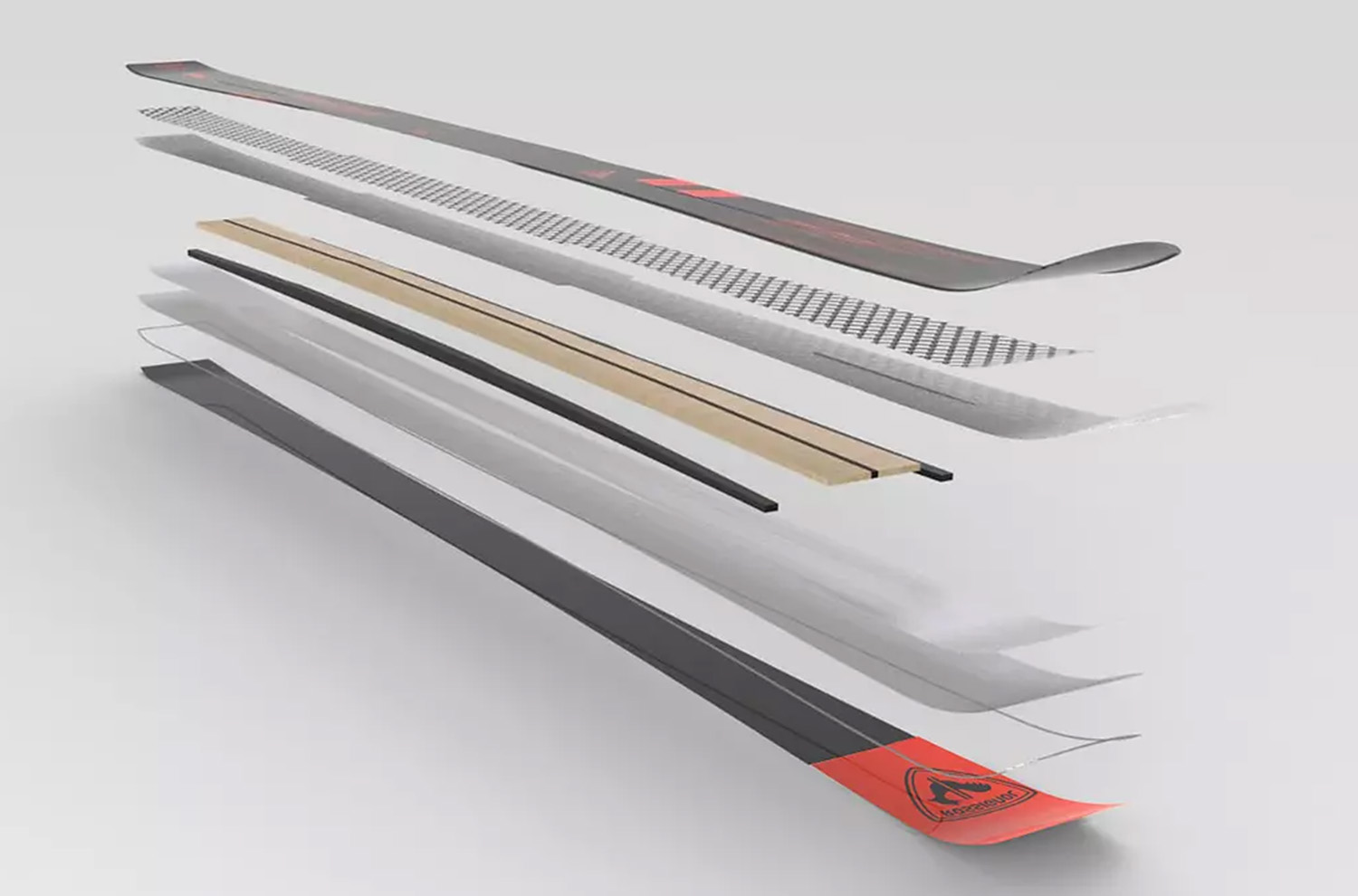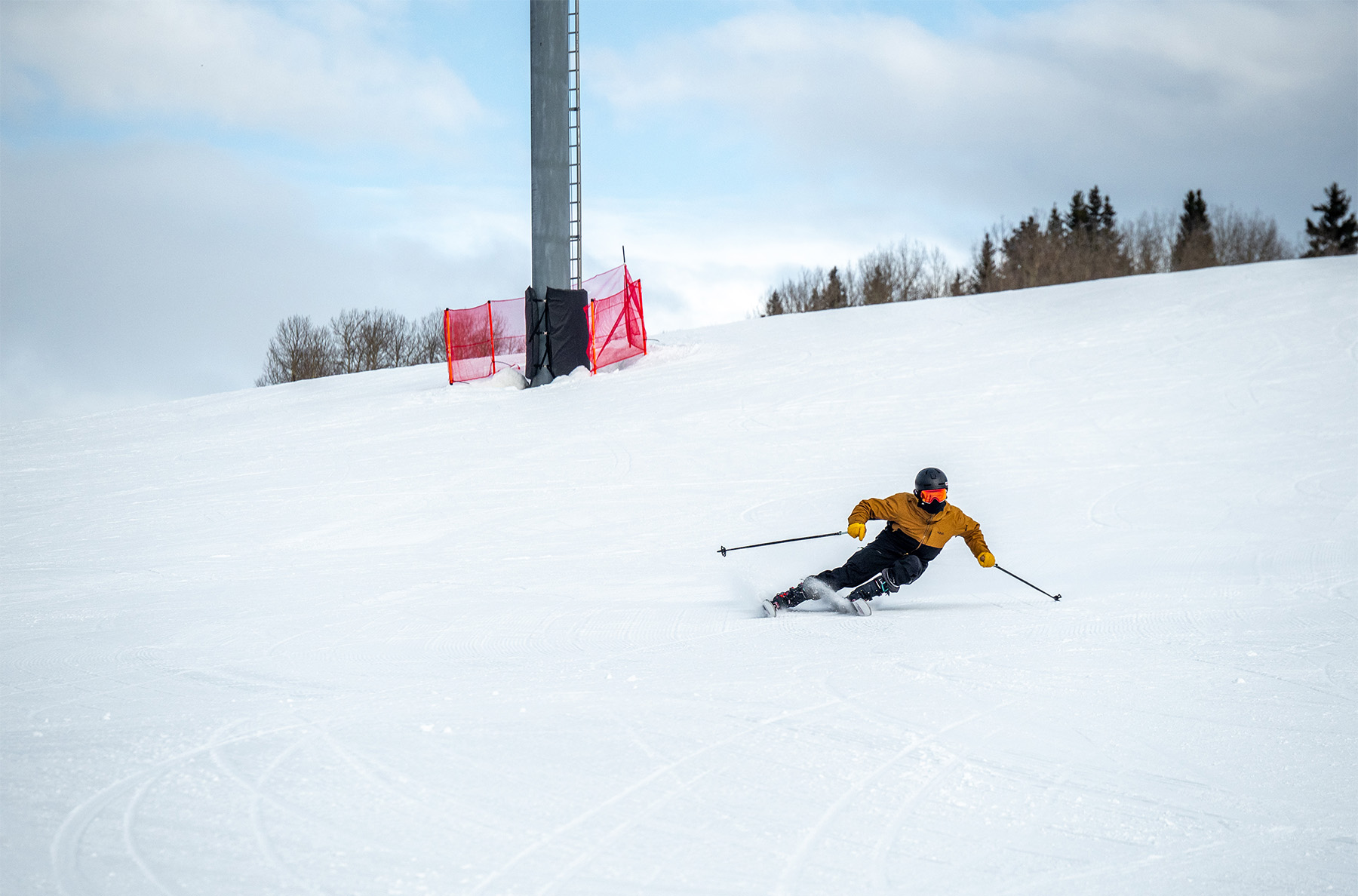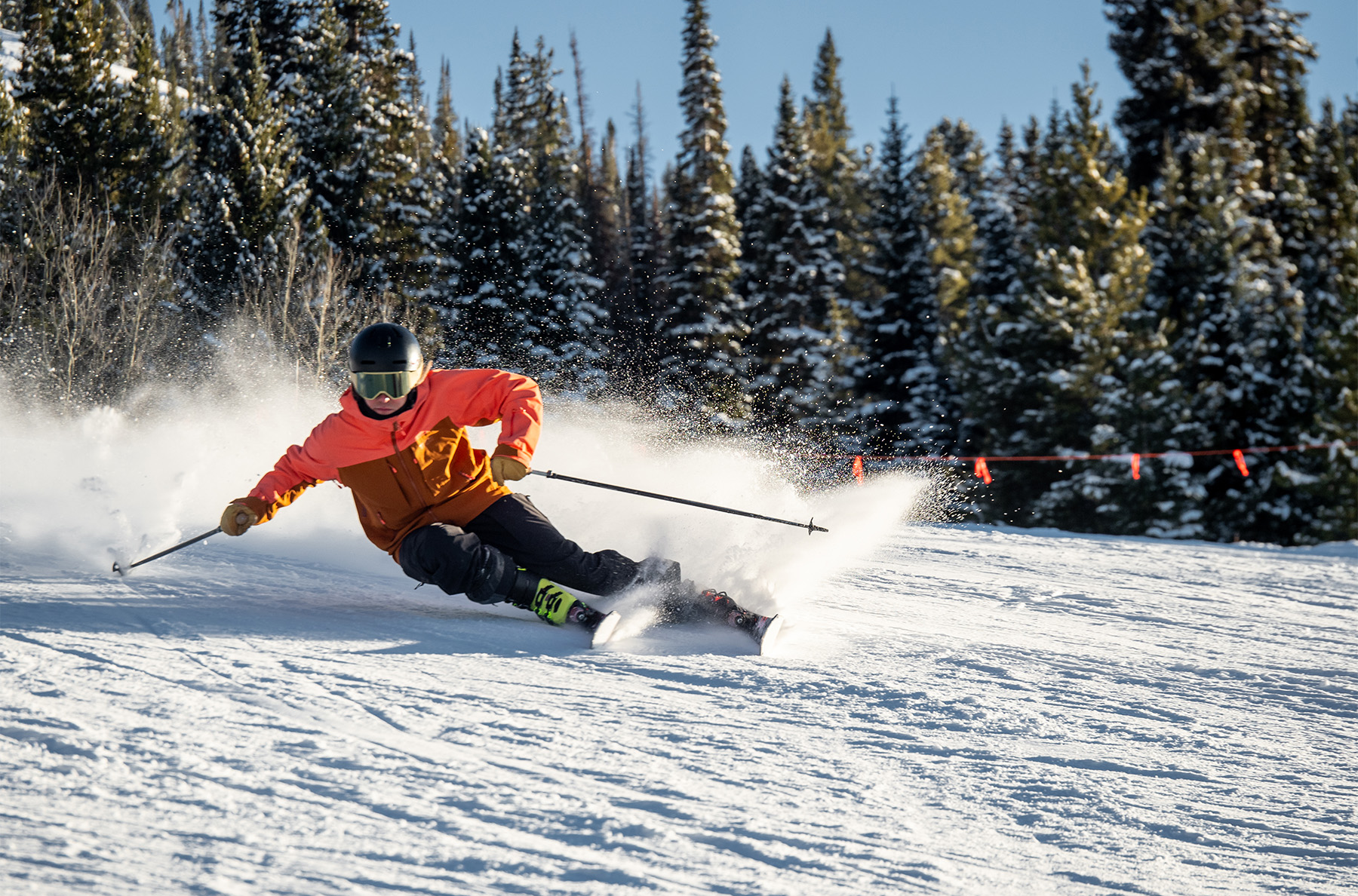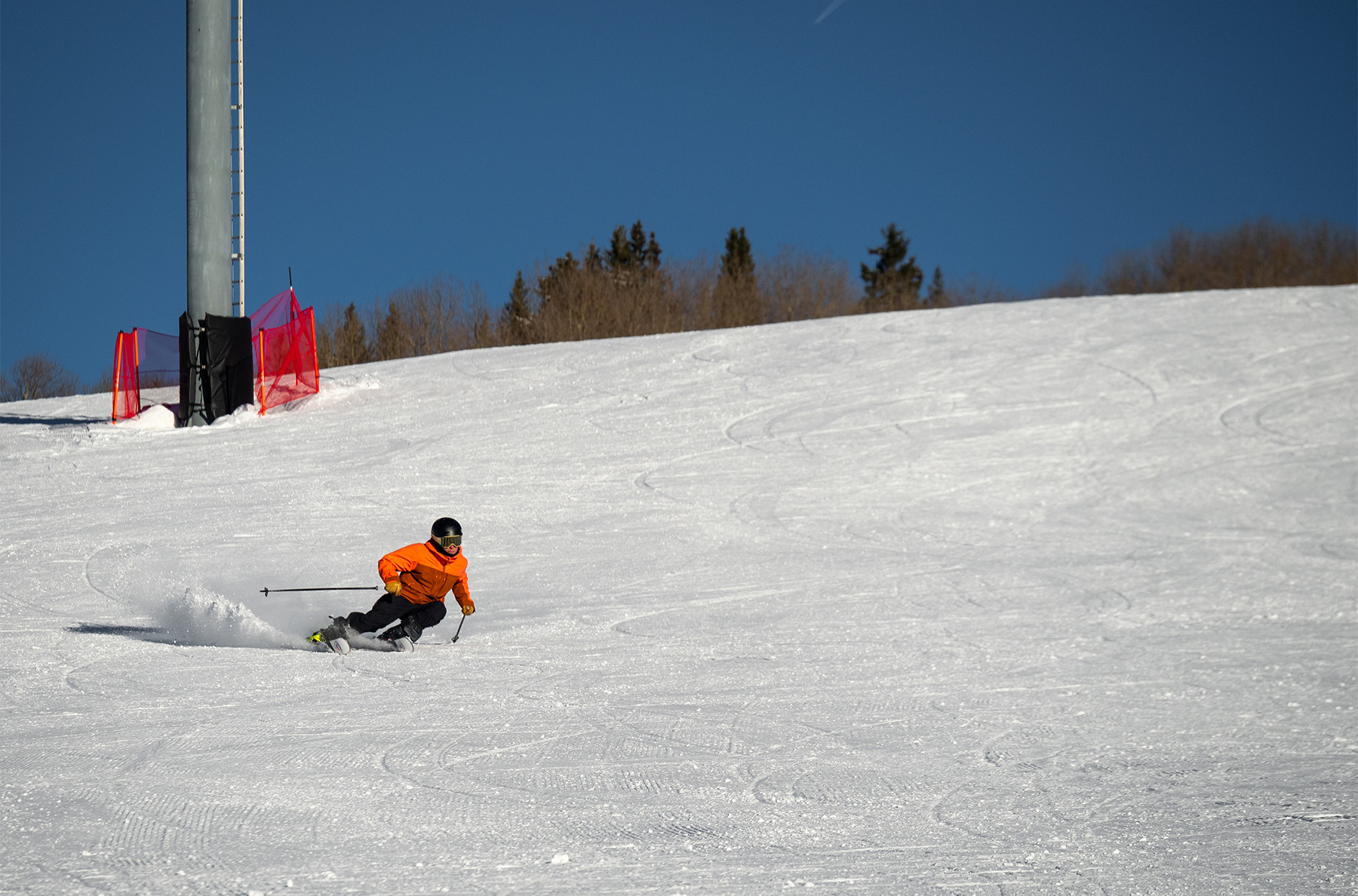Ski: 2023-2024 Rossignol Forza 70D V-Ti Konect, 173 cm
Test Location: Crested Butte Mountain Resort, CO
Days Skied: ~15
Available Lengths: 163, 173, 181 cm
Blister’s Measured Tip-to-Tail Length (straight-tape pull): 172.5 cm
Stated Weight per Ski (w/ binding plates): 1900 grams
Blister’s Measured Weight per Ski (no binding plates): 1701 & 1706 grams
Stated Dimensions: 134-77-110 mm
Blister’s Measured Dimensions: 133.1-76.5-109.5 mm
Stated Sidecut Radius (173 cm): 14 meters
Measured Tip & Tail Splay (ski decambered): 43 mm / 7 mm
Measured Traditional Camber Underfoot: 9 mm
Core Materials: poplar + titanal (~1.5 layers) + carbon, basalt, & fiberglass laminate
Base: sintered “Ultra High Density”
Factory Recommended Mount Point: -10 cm from center; 76 cm from tail
Boots Used: Lange Shadow 130 LV, Tecnica Mach1 MV 130, Fischer RC4 Pro LV, Atomic Redster CS 130
Bindings Used: Look SPX 14 K GW

Intro
New for the 2023-2024 season, Rossignol’s Forza ski collection consists of several piste-oriented skis that are designed with accessible carving in mind, especially relative to the brand’s more demanding, race-oriented Hero collection.
The Forza series spans several models, but what they all have in common are generally shorter sidecut radii, wide tips, and relatively narrow tails. The numbers in their names are a nod to edge angles, with the Forza 20D V-FG being the most beginner-oriented (20° edge angle), and the Forza 70D+ V-Ti Master R22 being the most expert-oriented (70°+ edge angle).
Just below that ski in the lineup is the Forza 70D V-Ti, and we’ve been skiing it ever since Blister Summit 2023. If you want to try it or any of Rossignol’s other skis, you can do so at Blister Summit 2024.
On that note, before we dive into our review, you can also check out our Blister Summit Brand Lineup video with Rossignol for more background info on the Forza series and their other new models (the Forza conversation is 0:37–8:11):
What Rossignol says about the Forza 70D V-Ti
“Full-speed carve and full angulation for expert skiers. The Rossignol Forza 70D V-TI Skis set a new standard for advanced carving. Oversized dimensions combined with Supersize Sidecut support aggressive angulation and maximum control through high speed arcs. Matched with race-proven construction, this innovative shape lets you roll between turns with full engagement and maximum fun factor. Race-Proven Dampening PEFC certified Poplar Wood Core limits vibration for race-proven stability with a focus on sustainability.”
Construction
There’s a lot going on with the Forza 70D V-Ti’s core materials. It starts with fairly traditional things like a PEFC-certified poplar wood core, sintered “Ultra High Density” base, and Rossignol’s “Premium Hardtop Topsheet.” It’s also got two layers of titanal, but they reportedly don’t extend all the way to the tip, with the goal of making it easier to initiate turns. (See our Brand Lineup video, above, for a detailed explanation of that.)

Then Rossignol adds their “Carbon Alloy Matrix,” which is a diagonal grid of carbon and basalt with linear fiberglass stringers. The Forza 70D V-Ti also features Rossignol’s “Line Control Technology” (aka, LCT), which is a stringer that runs through the middle of the wood core and is meant to “eliminates counter-flexing of the ski to ensure consistently smooth stability and dynamic control of your line.”
For reference, the Forza 70D+ V-Ti Master R22 we alluded to above is largely the same as the Forza 70D V-Ti Konect we’re reviewing here, except the “Master R22” version reportedly uses a denser ash wood core and comes with Rossignol’s R22 race plate.
Shape & Rocker Profile
The Forza 70D V-Ti’s shape is pretty striking. My eyes immediately get drawn to its huge tips that feature essentially no early tapering — the sidecut runs to the very end of the tips. As you move down the ski, it gets a whole lot narrower (77 mm underfoot), and then widens again at the tail. However, the tail is a good bit narrower than the tip (110 mm vs. 134 mm @ 173 cm), and the tail does feature a bit of early tapering at the end.
As for rocker, well, there isn’t much — the Forza 70D V-Ti is almost fully traditionally cambered.
Flex Pattern
Here’s how we’d characterize the flex pattern of the Forza 70D V-Ti:
Tips: 8.5
Shovels: 8.5
In Front of Toe Piece: 8.5-9
Underfoot: 9.5
Behind the Heel Piece: 9.5-9
Tails: 8.5-9
Hand-flexing the Forza 70D V-Ti, it actually feels pretty stiff overall, especially if you compare the flex of its tips and tails to most wider, all-mountain skis (which often have tips and/or tails that are notably softer than the middle).
However, the Forza 70D V-Ti’s flex pattern doesn’t feel like it stiffens up very quickly from the tips to the midsection. We’ll talk more about how this all adds up on snow in our Full Review section, below.
Sidecut Radius
All of the Forza skis generally have fairly tight stated sidecut radii. In the case of the Forza 70D V-Ti, its stated sidecut radii span from 13 meters for the 163 cm to 15 meters for the 181 cm, with the 173 cm length’s radius coming in at 14 meters.
Mount Point
No big surprise here: the Forza 70D V-Ti has a very traditional (and pretty standard for directional piste skis) recommended mount point of about -10 cm from true center.
Weight
Despite its metal layers and “expert-oriented” positioning, the Forza 70D V-Ti isn’t particularly heavy; it’s actually pretty light for its class. Our 173 cm pair came in at just over 1700 grams per ski with the binding plates removed.
For reference, here are some of our measured weights (per ski in grams) for a few notable skis. As always, keep in mind the length and width differences of each ski listed to keep things more apples-to-apples. Also, note which of these measured weights includes a given ski’s binding plates.
(FWIW, while we haven’t weighed every binding plate out there, the ones we have weighed typically weigh about 200-300 grams per ski.)
1701 & 1706 Rossignol Forza 70D V-Ti, 173 cm
1724 & 1735 Parlor Warbird, 178 cm
1728 & 1750 Renoun Atlas 80, 177 cm
1823 & 1853 Atomic Maverick 88 Ti, 184 cm
1832 & 1841 K2 Disruption 78Ti, 177 cm
1911 & 1917 K2 Disruption 82Ti, 177 cm
1915 & 1937 K2 Mindbender 89Ti, 182 cm
1990 & 2036 Blizzard Brahma 88, 177 cm
2008 & 2015 Folsom Spar 88, 182 cm
2098 & 2105 Nordica Enforcer 88, 179 cm
2142 & 2145 Stereo Piste RS, 175 cm (w/ binding plates)
2205 & 2206 Head Supershape e-Titan, 177 cm (w/ binding plates)
2235 & 2236 Elan Wingman 86 CTi, 184 cm (w/ binding plates)
2225 & 2248 K2 Disruption MTi, 175 cm (w/ binding plates)
2286 & 2299 Fischer RC One 82 GT, 180 cm
2304 & 2297 Head Supershape e-Rally, 177 cm (w/ binding plates)
2432 & 2445 Fischer RC4 The Curv, 185 cm (w/ binding plates)
Now, let’s get into how all of this adds up on snow:
FULL REVIEW
Turn Shapes
Luke Koppa (5’8”, 155 lbs / 173 cm, 70 kg): When I first saw the Forza 70D V-Ti, I expected it to basically feel like a Slalom ski. Its gigantic, spatula-like tips and far-skinnier waist looked like they’d immediately suck me into ultra-tight turns and probably only want to make those sorts of shapes.
I was kind of correct about the first part, but the Forza 70D V-Ti has proven to be more versatile than its sidecut made me suspect.
Overall, the Forza 70D V-Ti is definitely biased toward smaller, higher-edge-angle turns. It’s quite easy to bend the shovels and get carving very hard across the fall line. And I think that’s what is most fun to do on this ski — really try to make it live up to the supposed 70° edge angle in its name. It’s a blast.
However, this ski has been pretty adaptable in terms of different turns shapes and styles — at least when it comes to being predictable. If you don’t drive it very hard, it’s pretty intuitive to make bigger, lower-edge-angle and skidded turns. I figured its shape and sidecut radius would be what would hamper its performance when making longer, higher-speed turns; rather, I think its weight is a bigger factor (more on that below).
That said, if you want to truly and aggressively carve big GS turns, this isn’t your ski. Once you really start driving it and tipping it on edge, it wants to make fairly small turn shapes. But I do appreciate that it doesn’t force you to be fully committed to those turns all of the time; in that way, it’s way, way less demanding and niche than a true Slalom ski.
As a result of all this, I found myself enjoying the Forza 70D V-Ti the most on what I’d call low- to moderate-angle groomers (at Crested Butte Mountain Resort, our “green” and “blue” runs). It’s not the absolute most engaging ski on super flat slopes, but it doesn’t need a very steep pitch to come alive. On steeper “black” runs, the Forza 70D V-Ti either requires that you commit to carving a bunch of tight turns (which requires good technique and endurance due to the frequency), or just make bigger, more casual, more skidded turns.
Edge Hold
Overall, I’d say the Forza 70D V-Ti is pretty good when it comes to edge hold, but it does have some quirks that can take some getting used to.
Mostly, the Forza 70D V-Ti’s tips and tails don’t feel all that precise, especially relative to most other piste-oriented skis with similarly tight sidecut radii but that feel “locked in” from tip to tail. I have been able to cleanly carve the Forza 70D V-Ti on some very firm snow this season (e.g., the scraped-off, man-made rollovers that have been bordering on what I’d call “ice”). However, to do so, I found that I had to deliberately focus on my technique. Specifically, keeping everything “stacked” during the middle of the turn and not bending the front of the ski too much.
Of course, I think most of us are always trying to ski with as good of technique as possible, but I noticed more of an impact on the Forza 70D V-Ti’s edge hold when I focused on those things, relative to most other carving skis.
I think this is mostly the result of the Forza 70D V-Ti not feeling very longitudinally stiff at the tips and tails, and because it feels like it gets most of its edge hold from the middle 2/3 of the ski. If I just tried to drive its shovels as hard as possible and didn’t transition my weight bias slightly backward / centered around the middle of the turn, its tails could start to skid out and I didn’t totally trust it to hold on really firm snow. After more time with it, I adapted to the ski and was impressed by how hard I could carve it on icy sections, but there was a bit of a learning curve.
I think the main takeaway here is that, if you’re an aggressive, experienced skier looking for a ski that you’ll use for carving up ice, I’d probably recommend something a bit more traditional (e.g., Head Supershape e-Rally). Strong skiers with good technique may overpower the Forza 70D V-Ti. However, it’s also way more accessible than skis like the Supershape e-Rally, and on anything softer than scraped-off, man-made snow, I never had any issues with edge hold.
Suspension, Stability, & Variable Conditions
In most conditions on groomed slopes, I didn’t have any complaints about the Forza 70D V-Ti’s suspension. It’s not a particularly damp ski, especially compared to other (mostly heavier) metal-laminate carvers, but once we weighed it, I was surprised by how light it actually was — it offers a nice ride quality for its weight.
However, the Forza 70D V-Ti’s lower weight starts to show when conditions get firmer and/or more variable. Hitting piles of loose, pushed-around snow at speed on the Forza 70D V-Ti leads to notably more deflection than most heavier piste-oriented skis. Same goes for really firm, rough conditions such as the gravel-like snow that often covers man-made groomers at the beginning of the season. So, in scenarios like that, I found it easiest to just slow down and make more controlled, skidded turns. Or, if I was feeling up for more of a challenge, I’d try to come up with a line of tight, dynamic carves that avoided the piles of snow and connected the smoother, more consistent sections between them.
Overall, the Forza 70D V-Ti isn’t made for big, high-speed turns. It’s far from terrifying if you do end up doing that, but it feels happiest and most appropriate when making tighter, higher-edge-angle carves.
Energy / Pop
The Forza 70D V-Ti is a pretty lively ski once you push it. That said, its fairly soft, somewhat-vague-feeling tips and tails don’t feel quite as snappy as I expected. I’d compare it to a soft vs. stiff park ski; often, the softer skis are easier to bend and feel lively at lower speeds, but they don’t produce as much rebound / don’t push back as much when you’re putting a lot of force into them. Vice versa for stiffer skis — they might feel kinda “dead” if you’re not able to bend them at slow speeds, but they can feel explosive once you put in the effort to flex them.
On the Forza 70D V-Ti, I didn’t get quite as much rebound as I expected, especially when I think I was overpowering its shovels and consequently washing out the tails. Once I’d adjusted my technique a bit, it felt more lively.
In the end, I wouldn’t say this is a defining trait of the Forza 70D V-Ti — it’s neither exceptionally lively nor super “dead” and lifeless. It’s energetic enough for me to catch some air between turns, and that’s typically enough for me.
Moguls / Off-Piste Performance
The Forza 70D V-Ti is a piste-oriented ski and it feels like it. It is not what I’d choose if I wanted a ski that’d often be used in moguls, trees, and other off-piste scenarios.
However, it’s not quite as much of a handful in those situations as I expected. Its tail is actually pretty easy to release when you stay over the front of the ski, and its low swing weight helps.
Here’s how I’ve been thinking about it: if I had access to some mogul runs next to groomers where the bumps were pretty spaced out, I’d probably take the Forza 70D V-Ti through them a couple times a day, with the rest spent on piste. If I had to ski big, tight bumps, punchy off-piste snow, or any other more challenging non-groomed situations, I’d opt for a different ski. This isn’t an “all-mountain” ski.
Length
We’ve been spending time on both the 173 cm and 181 cm Forza 70D V-Ti. They’ve felt quite similar overall, with the differences basically being what you’d expect: the 181 cm needs a bit more speed and effort to get on edge, but is a bit more stable. The 173 cm feels more engaging at slower speeds and is easier to bend into tighter turns, but gets a bit more nervous when making bigger, faster turns (and it’s a bit easier to overpower).
Both lengths share the overall bias toward tighter turns rather than longer, higher-speed arcs, and neither is exceptionally stable. So at least for me, this is a case where I’m inclined to size down since I’m a bit caught between sizes (I’m 5’8”, 155 lbs / 173 cm, 70 kg and generally get along best with piste skis around 175-180 cm). I’d prefer to optimize the Forza 70D V-Ti’s exciting, tight-turning nature by sizing down, rather than reducing that for some marginal gains in higher-speed stability and support by sizing up.
Who’s It For?
The Forza 70D V-Ti is best suited to those who are in the market for a carving ski that excels at making tight, high-edge-angle turns. However, there’s more nuance to that.
If you’re a very experienced skier who has typically preferred stiff, heavy piste skis, and especially if you want to carve icy conditions, I’d look to something stronger and heavier. The Forza 70D V-Ti may look a bit like a Slalom ski, but it’s very different.
On the other end of the spectrum, I probably wouldn’t recommend the Forza 70D V-Ti to beginners and intermediates who are just learning to carve. It is pretty easy to get on edge and it’s not that hooky relative to its sidecut radius, but especially if you’re mostly skidding your turns and prioritize ease of use over precise carving performance, I’d go with something with a less dramatic sidecut and shape.
Then there are the people in the middle. Personally, I’d recommend the Forza 70D V-Ti to tons of high-intermediate to expert skiers who don’t fall into those two extremes that I just described.
The Forza 70D V-Ti makes it easy to carve tight, high-edge-angle turns, and especially for those who don’t spend much time on piste-specific skis, I think that could make it a blast. You don’t need perfect technique to carve this ski hard and it’s way more fun on piste than most wider all-mountain skis, but experienced skiers can also enjoy the finesse it encourages once you really start pushing it. Or, if you have skied stiffer, longer-radius carving skis and found them difficult to bend and/or not very engaging on moderate-angle slopes, the Forza 70D V-Ti could also be a great fit.
Bottom Line
The Rossignol Forza 70D V-Ti is an engaging and accessible carving ski that encourages you to ramp up your edge angles and tighten up your turns. At the same time, it’s a bit less niche and more versatile than its wild-looking shape might suggest. Its “expert-oriented” designation may scare off some skiers, but you definitely do not need to have perfect technique or a racing background to enjoy making turns on this ski.
Deep Dive Comparisons
BLISTER+ members and those who purchase our Digital Access Pass can check out our Deep Dive comparisons linked below. Get our Digital Access Pass to view all our Deep Dives and Flash Reviews, or become a BLISTER+ member today to get access to that and a LOT more, including the best worldwide Outdoor Injury Insurance, exclusive deals and discounts on skis, personalized gear recommendations from us, and much more.
Check out our Deep Dive comparisons of the Forza 70D V-Ti to see how it compares to the Head Supershape e-Rally, Head Supershape e-Titan, K2 Disruption 78Ti, K2 Disruption 78C, Fischer RC4 The Curv, K2 Disruption 82Ti, Fischer RC One 82 GT, K2 Disruption MTi, Elan Wingman 86 CTi, Parlor Warbird, Renoun Atlas 80, Dynastar Speed Omeglass WC FIS SL, Black Crows Mirus Cor, Folsom Spar Turbo, & Line Blade.








Tip and tail splay numbers from some other ski?
Good catch — just updated those.
Great review – I’m looking for a narrow/carving ski for my son, and Blister’s recent string of reviews have been really helpful in narrowing down options.
I personally like “heavy metal” Austrian racing skis (mostly Fischer and Head) but those don’t make any sense for him, and I was sort of at a loss how to proceed, so it’s great to see reviews of more friendly options like this.
How does this compare to the Hero Elite Plus TI
10mm wider waist, and wider tip along with that. Based on my quick test, Forza is more at home in mixed and softer snow conditions than the Hero Elite Plus. Also, requires slightly(*) less speed to get into a carving turn.
*) I tested the Forza Master, and did not compare to the non-Master version. To me, the Forza Master still required a fair bit of speed to carve, but not to the extent of a more comp-ski like SL/GS skis.